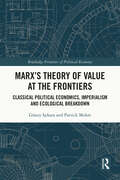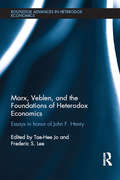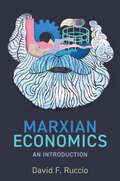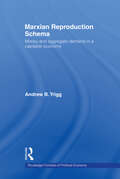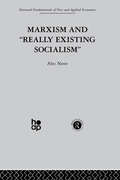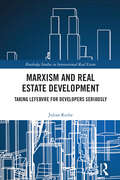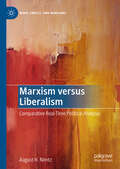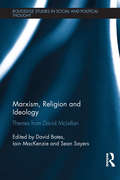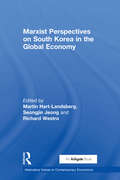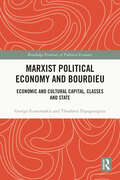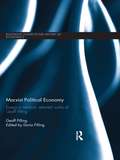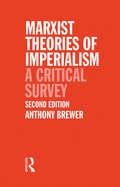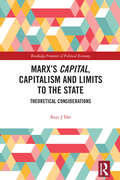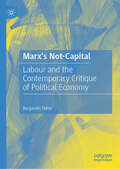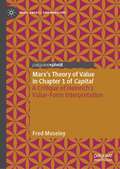- Table View
- List View
Marx's Theory of Value at the Frontiers: Classical Political Economics, Imperialism and Ecological Breakdown (Routledge Frontiers of Political Economy)
by Güney Işıkara Patrick MokreWhy do humans produce the things they do, in the way they do it? As this book shows, the classical political economics approach to value and prices has fundamental implications for analyzing the historical trajectory of capitalism.It demonstrates that the classical political economists’ approach to value and prices, which finds its most advanced formulation in Marx, sheds light on the source of profits, exploitation, whether equivalents are exchanged in trade, dynamics of asymmetric and uneven accumulation, and the relationship of production to non-human natures at large. Understanding these phenomena is key to understanding the economic regularities underlying the key issues facing the world in the twenty-first century: imperialism and ecological breakdown. It argues powerfully that deviations between market prices, production prices, and labor values are central to understanding international value transfers due to differential capital compositions and rates of exploitation, as well as the central role of rent and accumulation in capitalism-induced ecological crisis.The book is structured to provide an understandable introduction to the classical approach to value and prices, and its modern expression in empirical applications making it of great interest to readers in Economics, Political Economy, Politics and Sociology.
Marx, Veblen, and the Foundations of Heterodox Economics: Essays in Honor of John F. Henry (Routledge Advances in Heterodox Economics)
by Tae-Hee Jo Frederic LeeJohn F. Henry is an eminent economist who has made important contributions to heterodox economics drawing on Adam Smith, Karl Marx, Thorstein Veblen, and John Maynard Keynes. His historical approach offers radical insights into the evolution of ideas (ideologies and theories) giving rise to and/or induced by the changes in capitalist society. Essays collected in this festschrift not only evaluate John Henry’s contributions in connection to Marx’s and Veblen’s theories, but also apply them to the socio-economic issues in the 21st century. In Part I leading heterodox economists in the traditions of Marxism, Post Keynesianism, and Institutionalism critically examine Marx’s and Veblen’s theoretical frameworks (and their connections to each other) that have become the foundations of heterodox economics. Chapters in Part II showcase alternative theoretical explanations inspired by Marx, Veblen, and Henry. Topics in this Part include financial crisis, financialization, capital accumulation, economics teaching, and the historical relationship between money and class society. Part III is devoted to John Henry’s heterodox economics encapsulated in his "farewell" lecture, interview, and bibliography. Essays in this book, individually and collectively, make an important point that the history of economic thought (or historical analysis of economic theory and policy) is an integral part of developing heterodox economics as an alternative theoretical framework. Anyone who is troubled by the recurring failure of capitalism as well as mainstream economics will find this book well worth reading.
Marxian Economics: An Introduction
by David F. RuccioMore and more people have turned to Marxian economics in recent years. But isn&’t it a defunct branch of the &‘dismal science&’, disproven by the experience of the past 150 years, of no interest to anyone except historians? In this book, David Ruccio demonstrates why the answer to that question is a resounding &‘no&’. He offers a clear and accessible introduction to the basic concepts and theoretical strategies of Marxian economics, its key differences from mainstream economics, and its many applications to the real world. Focusing on Marx&’s critique of both mainstream economic theory and capitalism, Ruccio extends that analysis to contemporary topics—from inequality and economic crises to racial capitalism and the climate crisis—and outlines the key debates among Marxian economists. He concludes with a discussion of the ways Marxian economists today think about the possibility of moving beyond capitalism. The book is suitable for students and professors, as well as readers outside the academy interested in learning about Marxian economics. It will be useful both as a stand-alone text and as a companion to reading Capital.
Marxian Reproduction Schema: Money and Aggregate Demand in a Capitalist Economy (Routledge Frontiers of Political Economy)
by Andrew TriggIn 1878 Karl Marx developed the reproduction schema: his model of how total capital is produced and reproduced. This is thought to be the first two-sector economic model ever constructed. Two key aspects of Marx’s writings are widely agreed to be undeveloped: The role of aggregate demand and the role of money. This book synthesizes various strands of economic thought to enable the reader to understand and clarify the structure of the reproduction schema. This synthesis will challenge prevailing orthodoxies. This book constructs a macro monetary model which draws on a wide range of economic theories, within both the Marxian economic tradition, and the tradition of Keynes, Kalecki, Domar, Sraffa and Leontief. Marxian economics has been dominated by supply-side thinking, including general equilibrium theory and pronouncements about the shortage of surplus value, whilst Post Keynesians have failed to take seriously the importance of reproduction and the multisectoral structure of capitalism. By locating aggregate demand and the circuit of money in the reproduction schema, this key book provides an analytical contribution to both Marxian and Post Keynesian economics.
Marxism and 'Really Existing Socialism'
by A. NoveThe late Alec Nove explores the relationship between Marxist ideas and the Soviet reality and presents a methodology for understanding Soviet type societies.
Marxism and History (Theory and History)
by Matt PerryThis textbook examines Marxism’s enormous impact on the way historians approach their subject. Tackling current historiographical questions in an accessible way, the author offers a clear introduction to Marxist views of history, key Marxist historians and thinkers, and the relevance of Marxist theory and history to students’ own work. This is a concise, thorough overview of an important area of historiography. The second edition incorporates significant new developments in research, including Marxist contributions to the emergence of global, maritime and transnational history; the discovery of Marx’s ecologism and the historical critique of fossil capitalism as a source of environmental disaster; a reassessment of gender oppression through social reproduction theory; and the contribution of Marxism to debates on race, Eurocentrism and whiteness.
Marxism and Real Estate Development: Taking Lefebvre for Developers Seriously (Routledge Studies in International Real Estate)
by Julian RocheThis book straddles two worlds and attempts to bring them together: that of Lefebvre's Marxism on the one hand, and that of real estate development on the other. Lefebvre has now become a household name amongst many contemporary Marxists, especially those with an interest in urban planning and certain quarters of the architectural profession, however his work is far less well known by real estate professionals, whether investors, developers, brokers, or, indeed, policymakers. Marxism and Real Estate: Taking Lefebvre Seriously has both a large scope and a very bold aim – to use an explication and analysis of the work of Henri Lefebvre not only to present a critique of development, but, also to draw these two worlds together. It therefore, first, aims to present the arguments of this increasingly well-known French Marxist philosopher, sociologist, and pioneer of urban studies; second, to situate contemporary real estate development in the light of Lefebvre's work; and third, to analyse the potential application of Lefebvre’s work to each of the major components of contemporary real estate, to use Lefebvre's work in order to recommend practical action for developers, working alongside planners and architects, to influence the future of global real estate. As well as its direction at developers themselves, this book should be of interest to economists, real estate researchers and professionals, planners, urban studies scholars and, of course, to those interested in the application of Lefebvre's work to real estate.
Marxism versus Liberalism: Comparative Real-Time Political Analysis (Marx, Engels, and Marxisms)
by August H. Nimtz“An extraordinary work of political historical analysis that methodically and convincingly argues for the superiority of a Marxist approach for pursuing democracy. Rich in historical detail and thoroughly engrossing in portraying the real-time analyses of and intervention in crucial events by prominent Marxist and liberal theorists and political actors, Marxism versus Liberalism is a truly impressive achievement that will have an enduring appeal.” —John F. Sitton, Professor Emeritus, Political Science, Indiana University of Pennsylvania, USAPerforming a comparative real-time political analysis, Marxism versus Liberalism presents convincing evidence to sustain two similarly audacious claims: firstly, that Karl Marx and Frederick Engels collectively had better democratic credentials than Alexis de Tocqueville and John Stuart Mill; and secondly, that Vladimir Lenin had better democratic credentials than Max Weber and Woodrow Wilson. When the two sets of protagonists are compared and contrasted in how they read and responded to big political events in motion, this book contends that these Marxists proved to be better democrats than the history’s most prominent Liberals. Exploring the historical scenarios of The European Spring of 1848, the United States Civil War, the 1905 Russian Revolution, the 1917 Russian Revolution, and the end of World War I, Marxism versus Liberalism carefully tests each claim in order to challenge assumed political wisdom.
Marxism, Religion and Ideology: Themes from David McLellan (Routledge Studies in Social and Political Thought)
by David Bates, Iain MacKenzie and Sean SayersAs austerity measures are put into place the world over and global restructuring is acknowledged by all as an attempt to bolster the economic system that lead to the crash, there is a great need to come to grips with the economic, political and philosophical legacy of Marx. Of particular interest are Marx’s analyses of alienation and the cycles of boom and bust thought to be integral to the functioning of capitalism. Moreover, as the Cold War drifts into the history books, it is possible to reconsider the lasting impact of Marx’s analyses without the shadows cast by the Soviet version of communism. Equally, though, scholars are increasingly turning to Marx for insight into the rise of religion and the corresponding demise of political ideologies that seems to mark the contemporary age. Are we witnessing ‘the return of Marx’? Few scholars have done as much to tease out the intricacies of Marx, ideology and religion and their overlapping concerns as the eminent writer and Marx biographer, Professor David McLellan. This book brings together a group of internationally renowned academics to reflect upon, develop and criticise McLellan’s analyses of these three themes with a view to contributing more broadly to scholarly debates in these fields. This exciting and timely analysis will be of interest to scholars of political theory, the history of political thought (including historical methodology), Marx and Marxism, sociology of knowledge (particularly in relation to discussions of ideology), religion and theology more widely.
Marxist Perspectives on South Korea in the Global Economy (Alternative Voices in Contemporary Economics)
by Seongjin Jeong Martin Hart-Landsberg Westra RichardThis volume brings together work by international scholars to provide a unique analysis of the past, present and possible future trajectory of Korea's political economy from a distinctly Marxist perspective. The volume differentiates the Marxian approach to the political economy of Korean development from the Keynesian, social democratic approach that currently dominates the critical literature. In doing so the volume provides a unique view of the development of the South Korean Economy.
Marxist Political Economy and Bourdieu: Economic and Cultural Capital, Classes and State (Routledge Frontiers of Political Economy)
by George Economakis Theofanis PapageorgiouThis book systematically addresses Bourdieu’s key ideas and concepts in the context of Marxist thought. In this book, Bourdieu’s central theoretical points are analyzed within a political, sociological and politico-economic framework which allows for the development of a sequential narrative of his key ideas. Thus, the authors are able to highlight the theoretical consistencies and political conclusions which can be derived from Bourdieu’s work. For example, Bourdieu’s anti-neoliberal narrative is correlated with his analysis of class, and especially with his canonization of the petty bourgeoisie and its strategy for a reformed anti-neoliberal capitalism. The book also analyzes this coherent synthesis of Bourdieu’s work in the context of Marxist political economy, including not only Marx but also Lenin, Althusser and Poulantzas. In this context, the book explores Bourdieu’s work on the state, class strategy, socialism and capitalism. This unique perspective will be of great interest to social scientists, particularly in economics, politics and sociology, working on Bourdieu, Marx and capitalism.
Marxist Political Economy: Essays in Retrieval: Selected Works of Geoff Pilling
by Geoff PillingGeoff Pilling’s work shows that Marxist theory is relevant to those struggling to understand the problems of capitalist society today, and that the work not only of Marx and Engels but that of later Marxist theorists, including Lenin is worth studying. It also shows that to understand the problems of today’s society needs more than narrow specialist economic analysis, but a deep awareness of current developments in society.
Marxist Theories of Imperialism: A Critical Survey
by Tony BrewerThe last two hundred years have seen a massive increase in the size of the world economy and equally massive inequalities of wealth and power between different parts of the world. They have also witnessed the rise to dominance of the capitalist mode of production. Marxists, from Marx himself through to present day thinkers, have argued that these changes are profoundly interconnected. This book offers a unique account of Marxist theories of Imperialism. It has been fully updated and expanded to cover all the developments since its initial publication and will be essential reading for any student of Marxism.
Marx’s Capital, Capitalism and Limits to the State: Theoretical Considerations (Routledge Frontiers of Political Economy)
by Raju J DasMarx’s Capital examines the capitalist state in the abstract, and as it exists in advanced capitalism and peripheral capitalism, illustrating the ideas with evidence from the North and the South. The volume unpacks the capitalist state’s functions in relation to commodity relations, private property, and the crisis-ridden production of (surplus) value as a part of the capital circuit (M-C-M′). It also examines state’s political and geographical forms. It argues that no matter how autonomous it is, the state cannot meet the pressing needs of the masses significantly and sustainably. This is not because of so-called capitalist constraints, but because the state is inherently capitalist. Each chapter begins with Capital volume 1. And, each chapter ends with theoretical/practical implications of the ideas which taken together counter existing state theory’s focus on state-autonomy and reforms, and point to the necessity for the masses to establish a new transitional democratic state. But the book goes ‘beyond’ Marx too, as it deploys the combined Marxism of 19th and 20th centuries. Marx’s Capital will interest scholars researching state-society/economy relations. It is suitable for university students as well as established scholars in sociology, political science, heterodox economics, human geography, and international development.
Marx’s Not-Capital: Labour and the Contemporary Critique of Political Economy
by Benjamin TetlerAs a contribution to critical social theory, this book reconsiders Marx’s critique of political economy through the concept of labour as “not-capital”. Engaging with thinkers who have dealt with Marx’s concepts of “not-capital” and “not-value”, Tetler examines whether and how these concepts can contribute significantly towards a renewal of the critique of political economy beyond the limits of traditional Marxism. In doing so he provides the first in depth interrogation of these concepts, both within Marx’s work itself and within and across the various intellectuals who have put them to use in their attempts to address the faults of traditional Marxism. He argues that the theory of value that sits at the heart of Marx’s critique of political economy requires a negative conception of labour. In helping establish this, the notions of labour as not-capital/value are shown to have formidable ramifications concerning the crisis-ridden nature of capitalist social relations and the struggles operative within and against them.
Marx’s Theory of Value in Chapter 1 of Capital: A Critique of Heinrich’s Value-Form Interpretation (Marx, Engels, and Marxisms)
by Fred MoseleyChapter 1 is the most important chapter in Capital, as well as the most difficult and the most controversial. An influential interpretation of Chapter 1 in recent decades has been the so-called “value-form interpretation” of Marx’s theory in general and Chapter 1 in particular. The most important proponent of the value-form interpretation today, both in Germany and in the English-speaking world, is Michael Heinrich, and Heinrich’s work has emphasized the first chapter. Heinrich’s latest book in English is a detailed commentary of the first seven chapters of Volume 1 of Capital. The publication of an English translation of Heinrich’s book is an important event in Marxian scholarship and it is important to critically engage with this important book in order to advance our understanding of this critical foundational chapter. This book emphasizes the quantitative issue of whether the magnitude of value and socially necessary labour-time are determined in production or also depend on exchange and demand, which has been the main issue in the controversy over the value-form interpretation.
Marx�s Theory of Price and its Modern Rivals
by Howard NicholasMarx's Theory of Price and its Modern Rivals provides an original look at how Marx understood the role of money, extending his theory to consider how prices move over the course of business cycles. Key modern theories of price are also analysed; Neoclassical, Post Keynesian and Sraffian theories are contrasted with Marxian thought.
Mary Caroline Tillman at Egon Zehnder: Spotting Talent in the 21st Century
by Francesca Gino Bradley R. StaatsThis case investigates both micro and macro issues around strategic human capital development. First, it explores how Egon Zehnder, a leading global search and advisory firm, assesses talent in the firms for which it works. The case discusses the deployment of a unique potential model that substantially shifts how the company views individuals. Within this framework, Mary Caroline Tillman, the case protagonist, is faced with an evaluation decision between two candidates who have different competencies, past experience and potential. Second, the case also explores the macro issues of running a professional services firm. The case presents an opportunity to examine how and if the organization can change its focus to include more assessment opportunities.
Mary Caroline Tillman at Egon Zehnder: Spotting Talent in the 21st Century
by Francesca Gino Bradley R. StaatsThis case investigates both micro and macro issues around strategic human capital development. First, it explores how Egon Zehnder, a leading global search and advisory firm, assesses talent in the firms for which it works. The case discusses the deployment of a unique potential model that substantially shifts how the company views individuals. Within this framework, Mary Caroline Tillman, the case protagonist, is faced with an evaluation decision between two candidates who have different competencies, past experience and potential. Second, the case also explores the macro issues of running a professional services firm. The case presents an opportunity to examine how and if the organization can change its focus to include more assessment opportunities.
Mary Griffin at Derby Foods
by Anthony J. Mayo Joshua D. MargolisMary Griffin, Vice President of Consumer Products, must provide feedback to one of her direct reports, Simon York. York is a strong performer, but he has displayed some poor interpersonal skills in the manner in which he interacts with his team and the production staff. Griffin needs to provide feedback to help prevent York from derailing in his career at Derby Foods.
Mary Griffin at Derby Foods
by Anthony J. Mayo Joshua D. MargolisMary Griffin, Vice President of Consumer Products, must provide feedback to one of her direct reports, Simon York. York is a strong performer, but he has displayed some poor interpersonal skills in the manner in which he interacts with his team and the production staff. Griffin needs to provide feedback to help prevent York from derailing in his career at Derby Foods.
Mary Guerrero and the Advancement of Latinx Talent: Developing an Employee Resource Group at a Top Tier Bank (A)
by Rosabeth Moss Kanter Amy Hernandez TurciosMary Guerrero was a first-generation Latina and an investment banking analyst at a top tier bank on Wall Street-Bulge Bracket Bank (BBB). She was passionate about increasing representation of Latinx talent at her firm. She was already doing a lot of individual work to make this happen (e.g. reviewing candidate resumes at 2am after she had finished her assigned work). She wanted to scale her efforts and debated whether she should build a broader coalition to move the needle on Latinx talent representation despite having a demanding full-time workload.
Mary Guerrero and the Advancement of Latinx Talent: Developing an Employee Resource Group at a Top Tier Bank (B)
by Rosabeth Moss Kanter Amy Hernandez TurciosMary Guerrero decided to pursue the challenging road and kicked off Hispanic/Latinx Advancement and Career Engagement (HACE) at her Bulge Bracket Bank (BBB). For Mary, her larger purpose was to advance Latinx talent in the U.S. because she believed it was important for leadership at major U.S. firms to mirror the composition of the country. With Latinx representing almost 18.3% of the U.S. population but only holding 3.8% of board seats, she saw a problem that needed to be addressed.13 14 She understood what getting a job at a prestigious Bulge Bracket Bank on Wall Street meant for a Latinx. It meant not only learning hard skills like financial modeling but also earning credibility.15 Mary's life journey from growing up in a low-income neighborhood to earning a coveted spot on Wall Street was difficult and she wanted to make that path easier for others.
Mary Kay Cosmetics, Inc.
by John P. Kotter John M. StengrevicsIntroduces the student to Mary Kay Cosmetics, Inc., its business, its strategy, and its organization. Provides the necessary background for understanding the contributions of Mary Kay Ash, the company's founder and chairman.
